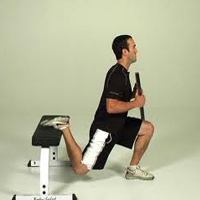| |
| Bodyweight exercise |
 |
Bodyweight exercises are strength training exercises that do not require free weights; the practitioner's own weight provides the resistance for the movement. Movements such as the push-up, the pull-up, and the sit-up are some of the most common bodyweight exercises.
In general, increasing the amount of repetitions will focus on improving endurance, while strength gains are made through increasing the intensity of the exercise through decreasing leverage and working at the ends of range of motion. |
| |
 |
|
Advantages |
Because they do not require weights, bodyweight exercises are the ideal choice for individuals who are interested in fitness but do not have access to equipment. However that doesn't mean strength can't be gained when practicing it. Weights can be incorporated to increase the difficulty of most bodyweight exercises and some exercises do require some sort of apparatus to lean on or hang from, but the majority of bodyweight exercises require only a floor. For those exercises that do require equipment of some kind, a substitute can usually be improvised, for example using two branches of a tree to perform tricep dips. Some bodyweight exercises have been shown to benefit not just the young, but the elderly also.
Bodyweight exercises, compared to weight lifting, often require much more flexibility and balance in order to perform repetitions. Such exercises include handstand pushups, planche pushups, and bridges. Many bodyweight exercises can be progressed or regressed to meet the individual's need. This progression/regression strategy allows nearly all levels of fitness to participate. Bodyweight training can be used effectively to strengthen the core muscles with the addition of speed or unstable surfaces (such as a stability ball) as well as exercise variations that limit the motion (such as extra wide push-ups or wide pull-ups. |
Disadvantages |
Bodyweight exercises use the practitioner's own weight to provide the resistance for the movement. This means that the weight being lifted is never greater than the weight of one's own body (which is never essential in bodybuilding). This makes it difficult for less experienced athletes to achieve a level of intensity that is near their one rep maximum (although of existing bodyweight exercises hard enough to achieve it), which is desirable for strength training. Other methods for increasing intensity include using additional weights (such as wearing a weighted vest or holding a barbell, sandbell or plate during a sit up) or by altering the exercise to put one's self at a leverage disadvantage (such as elevating the feet, hanging from straps to change leverage, using one limb, and incorporating isometrics).
Gymnasts make extensive use of this last technique by doing much of their training with straight arms (such as iron crosses, levers, and planches), a mechanically disadvantaged position. Furthermore, a unilateral progression scheme can be used. Instead of a bilateral movement, such as a two-handed pull-up, the practitioner may decide, for strength increases, to choose a set of exercises that will allow him/herself to complete the one-arm pull up. In the bodyweight-training community, unilateral movements are highly regarded and sought after.
|
| |
|
|

